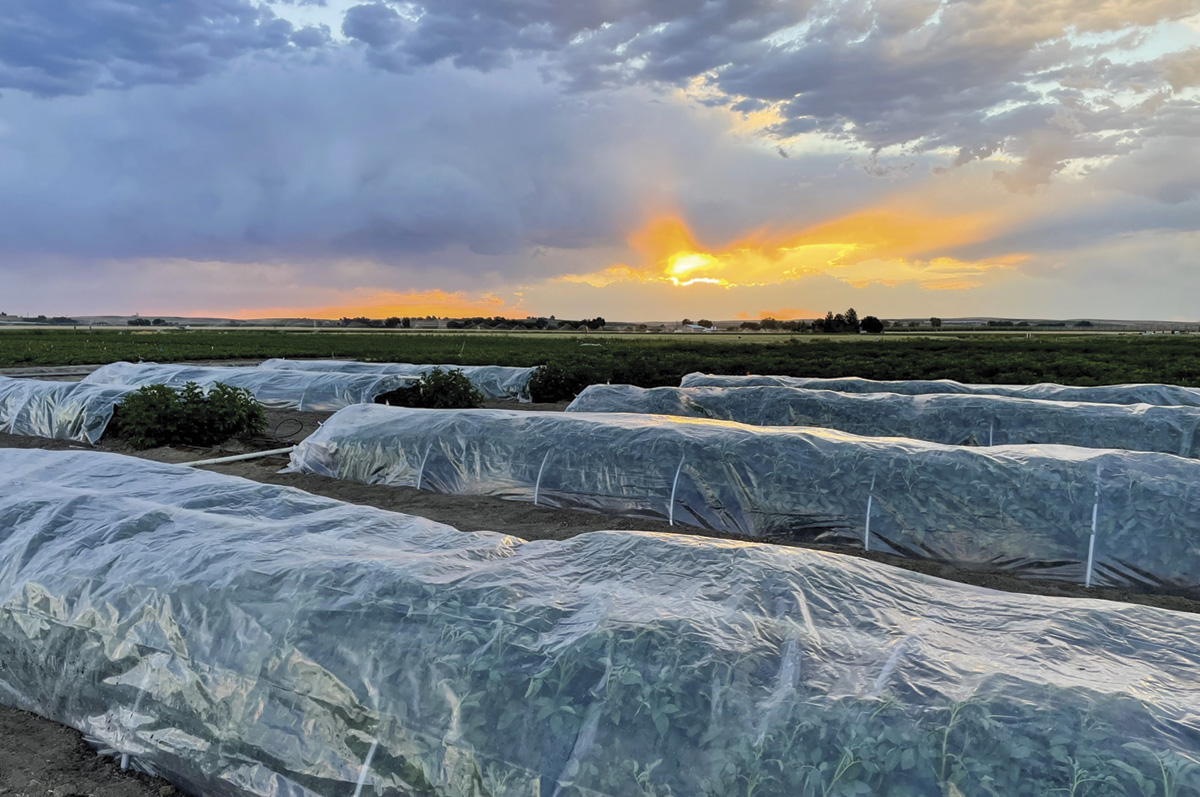Idaho residents breathed a sigh of relief in 2022 and 2023 when wildfire smoke was less pronounced than it had been in several of the preceding years. This “smoke break” was not enjoyed, however, inside special potato plots at the University of Idaho (U of I) Parma Research and Extension Center (PREC).
There, researchers used clear plastic over a hoop system to hold smoke over plots of growing potato plants every morning from 6 to 9 for six weeks in July and August. “No one else had done this on potatoes and no one else had done this in the field,” says U of I professor Mike Thornton, who co-led the study. “Usually, it’s done in the lab on a single plant or even part of a plant.”
But in order to collect the desired information about yield, size, quality, storability and processing characteristics in three different varieties, researchers needed to produce several hundred pounds of potatoes, and that meant developing a field test. “This was one of those projects that really started with a prompt from industry,” says Thornton.
“I noticed the opportunity for the project to exist 12 years ago,” says Dr. Addie Waxman, who is the manager of North American Potato Storage at McCain Foods. While on a crop tour in Washington, she saw a potato field that had senesced too early. “The producer told me, ‘That variety doesn’t do well when there’s a smoky season,’” she says. “I have been trying to get interest in the idea since.”

Clear plastic over hoop frames held smoke over the potato plants for three hours each morning for six weeks. Photo by Deron Beck.
Collaboration on a unique question
Pulling together researchers from U of I and Boise State University, with support from the Idaho Potato Commission and McCain Foods, the project received an ISDA grant and took off in 2022. Researchers specifically wanted to identify impacts of the chemicals in the smoke. Light quality, heat, ozone and water scarcity all impact potatoes in their own right, says Thornton. “We know that, from studies that have been done on those factors.” The challenge was to experiment with smoke while holding the other environmental factors constant.
To keep the enclosures from falsely elevating temperatures in the potato plots, researchers removed the plastic from plots (including the non-smoky “control” treatment) every day before they had a chance to get too hot.
This limited smoke infusion to early morning, actually mimicking reality in two important ways. “Smoke settles down near the ground in the evening and early morning,” says Thornton. Then, potato leaves’ pores open for air intake in the morning hours before closing in the heat of day. So it’s reasonable to surmise that much of these plants’ wildfire smoke exposure would naturally occur in this early-morning window.
Then there was the seasonal timing. “We chose that six-week period because almost every year we have bad wildfires, that is when we see the highest smoke levels,” says Thornton.

Other researchers used the same protocol to study smoke impact on bean pathology, beginning in 2023. Photo by Mack Murdock.
Plant stage also matters. “If the plant is already senescing, [smoky conditions] may speed that up. If it’s just putting on new leaves, it may recover pretty quickly,” says farmer Ritchey Toevs of Aberdeen. In July and August, when the researchers applied their smoke treatments, potato plants were tuber bulking – a stage when researchers predicted yield would be most impacted by adverse conditions.
To generate smoke, researchers built fires in a 50-gallon drum, using slash from Idaho Power and wood pellets for fuel. “It made a nice thick smoke,” says PREC Plant Pathology Field Trials Manager Mack Murdock, who is now involved in a similar study on dry beans. That smoke was channeled through PVC pipe to the 6-by-30-foot plots to a concentration that would be considered “very unhealthy” on the air quality index.
The slash – which included wood bits, needles and bark – helped the researchers mimic forest rather than rangeland fire smoke, another point for lifelike conditions. “These rangeland fires can be really dramatic,” says Toevs, “but they burn out pretty quick.” In his area, he says, lingering smoke is typically that blown in from forest fires in southern Oregon and northern California.
2% to 3% yield loss
“The bottom line is,” says Thornton, “if you have a lot of smoke, you can expect potatoes to be less productive, especially top-grade potatoes.” He found that yield in the smoke-treated plots dropped 2% to 3% each year. Extrapolating to the statewide level, a very smoky year could mean a loss of over 7 million 100-pound bags of U.S. No. 1 potatoes. Researchers also noticed that the smoke-affected plots yielded smaller and more misshapen potatoes.
“We didn’t see that variety is a big factor,” says Thornton, “and there was no change in storability.” However, he adds, “Stress of any kind in potatoes is additive, so a field that is experiencing water, nutrient or disease stress would be expected to be more impacted by smoke. That might explain how some growers notice big changes in smoky years and others not so big of a change.”

Thick smoke inside the enclosures resulted in a 2%-3% yield loss and an increase in small, misshapen potatoes. Photo by Deron Beck.
More commodities, more questions
Based on these results – and the novel protocol – producers can look for other commodities to receive similar treatment in the near future. A preliminary test in garden and pinto beans last year showed that smoky conditions caused some leaf surface damage, says Murdock. Researchers will investigate smoke timing and frequency in pinto beans this year. “We’re interested in how smoke affects pathology,” Murdock says, in contrast with Thornton’s agronomic focus. The bean researchers are particularly interested in airborne pathogens carried in the smoke – but, says Murdock, “I would guess that anything that weakens the plant in general will make it more sensitive to plant pathogens.”
If so, bean producers may benefit from more proactive disease management. “They may want to apply protective fungicides when smoke appears,” he says.
Another question is how smoke impact will interact with environmental factors. “The effect isn’t linear – a lot like farming,” says Toevs.
Toevs suspects that reduced solar radiation may make a bigger difference to potatoes than the smoke itself. “With less radiation, you use less water. We may need to manage that – which, of course, we’re always trying to do anyway.”
With current information, that focus on managing for general health may be the producer’s best recourse. However, further research on timing and interaction with other factors may yield helpful insights.
Waxman is hopeful that the 2023 potato crop will give a clearer picture when they come out of storage to be tested for quality factors. “Our smoke generation was so much better in year two,” she says. She is particularly interested in whether varietal differences will appear.
But even if those differences fail to appear, the results already seen show a clear impact of smoke on potato production. “I think in some ways it will be confirming what producers have already suspected but couldn’t put their finger on, and that’s important,” says Waxman.







